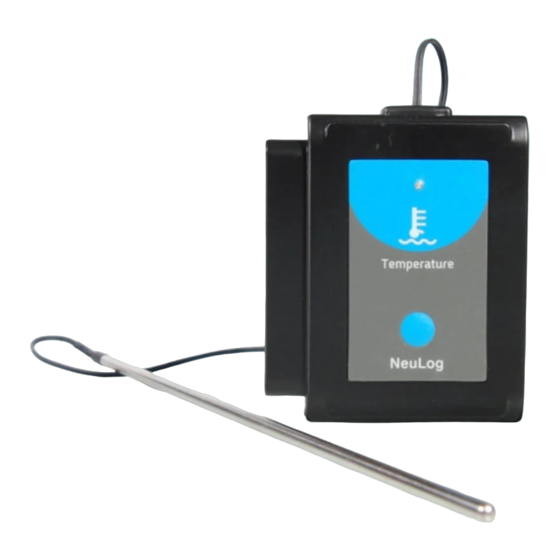
Table of Contents
Advertisement
Quick Links
NeuLog temperature logger sensor
NUL-203
The NeuLog temperature sensor can be used to take temperature measurements in
solids, liquids, or gases for any science experiment where a thermometer is required.
It is used in the fields of Chemistry, Physics, Biology, Earth Science, Environmental
Science, etc.
The sensor comes pre-calibrated so you can start experimentation right out of the box
using any of the following guides.
Just a few of the thousands of possible experiments that can be performed with the
NUL-203 sensor are: Monitoring of ecological systems, study of photosynthesis, effect
of temperature on enzymes, endothermic and exothermic reactions, heat and energy
transfer, weather studies, insulation studies and ideal gas law studies.
This sensor is capable of measuring both in Celsius and Fahrenheit.
0
Celsius (
C): The SI (International System of Units) unit of temperature.
0
Fahrenheit (
F): The temperature measurement unit of the English System
commonly used in the United States.
Quick start procedure:
PC or Mac Computer
Materials needed:
NUL-203 Temperature Sensor
USB-200 USB Module
USB to mini USB cable (included with the USB-200 module)
Your temperature sensor needs to be connected to a USB-200 module. The USB-200
module then connects to a computer via USB. Please note that you cannot plug the
temperature probe directly to the computer.
Resident PC software and browser based application can be downloaded for free at
www.neulog.com/Download/SoftwareandApplication.aspx
user guide.
Note: Make sure not to download and install both types of software they will conflict
on the computer.
NEULOG TEMPERATURE LOGGER SENSOR GUIDE
Procedure:
1.
2.
3.
4.
5.
6.
7.
8.
9.
10.
11.
12.
Tablet, smart phone device
Materials needed:
Your Temperature Sensor needs to be connected to a WiFi-201 module. The WiFi-
201 module will create a closed NeuLog WiFi network which will stream the NeuLog
data to the device of your choosing. Once your device is wirelessly connected to the
NeuLog network you can run experiments and collect data through a browser of your
choosing.
as well as a full software
Procedure:
1.
2.
Install the NeuLog software.
Connect the USB-200 module to the PC or Mac.
Connect the temperature sensor to the USB-200 module (they directly plug
together). Please note there is no calibration required for this sensor.
Open the NeuLog software.
Once a temperature sensor logo appears on the left side of the screen, the
probe has been automatically identified and you can begin experimentation.
If the temperature sensor is not automatically identified, click the "Search for
sensors" icon to find the sensor.
Select the "On-line experiment" button; this will open a graph below.
Click on the "Module setup" button located on the temperature sensor icon in the
module window to change the temperature probe settings if need be (Celsius or
Fahrenheit for example).
Click on the experiment set up button to change the experiment settings if need
be (Experiment duration for example).
The temperature sensor will give a live reading in the box to the left of the screen
when running.
To run an experiment and collect data click "Run experiment".
To end data collection early, click "Stop experiment".
NUL-203 Temperature Sensor
WiFi-201 WiFi Module
BAT-200 Battery Module
Connect the Temperature Sensor directly to the left side WIFI-201 (no wires
required).
Connect a BAT-200 module to the right side of the WiFi-201 module.
Advertisement
Table of Contents

Summary of Contents for NeuLog NUL-203
- Page 1 Your temperature sensor needs to be connected to a USB-200 module. The USB-200 201 module will create a closed NeuLog WiFi network which will stream the NeuLog module then connects to a computer via USB. Please note that you cannot plug the data to the device of your choosing.
- Page 2 To run an experiment and collect data, click the run button (little green person). Take your tablet or smart phone, go to the Wi-Fi settings and select the Neulog network which matches the WiFi Module ID found on the back of the WiFi-201 device.
- Page 3 Resolution (Celsius) ability to store its own data due to an internal flash memory chip and micro-controller Resolution (Fahrenheit) in each plastic NeuLog body. This technology allows the sensor to collect and then Maximum sampling rate 100 samples/second store the digital data in the correct scientific units (...
- Page 4 Never submerge the NeuLog plastic body in any liquid Do not allow liquid into the NeuLog plastic body where the temperature tether enters the body. After using the probe, wipe off all excess material, liquid or residue from the temperature probe.
















Need help?
Do you have a question about the NUL-203 and is the answer not in the manual?
Questions and answers